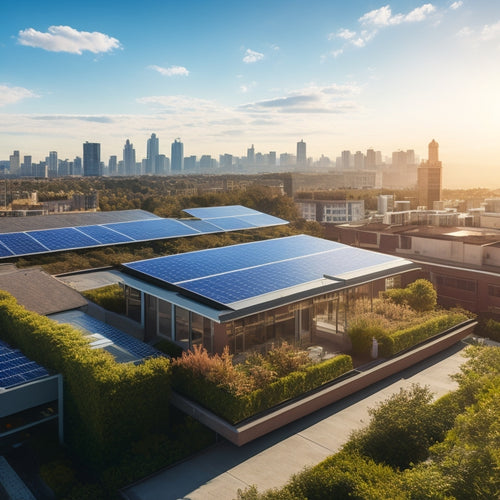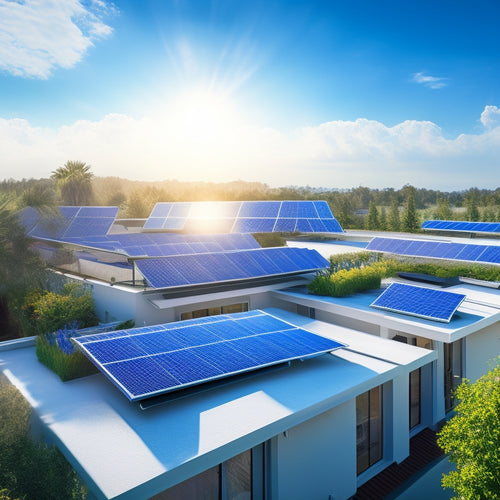
Best Solar Energy Solutions for Your Home
Share
You're looking for the best solar energy solutions for your home, and you've got plenty of options to evaluate. When it comes to solar panel systems, high-efficiency panels are ideal for limited roof space, generating more power while offering long-term savings. Energy storage solutions like lithium-ion batteries can maximize your solar panel efficiency, storing excess energy for later use. Solar water heaters can reduce your reliance on traditional energy sources, leading to significant savings on water heating bills. Ground mount solar racking and solar inverter technologies are also essential to assess. As you investigate the world of solar energy, you'll uncover even more innovative solutions customized to your unique needs.
Key Takeaways
- High-efficiency solar panels are ideal for limited roof space, generating more power and offering long-term savings despite higher installation costs.
- Energy storage solutions like lithium-ion batteries maximize solar panel efficiency by storing excess energy for later use.
- Solar water heaters can reduce water heating bills by up to 50% and produce zero emissions, making them an environmentally friendly option.
- Ground mount solar racking systems require a site assessment to ensure optimal configuration, durability, and ease of maintenance.
- Choosing the right solar inverter technology, such as string, micro, or power optimizers, depends on budget, system size, and monitoring needs.
Top Solar Panel Systems
When it comes to utilizing solar energy, a dependable solar panel system is essential. You need a system that can efficiently convert sunlight into electricity while withstanding various environmental conditions.
To achieve this, you must consider solar panel efficiency, which is measured by the amount of energy produced per unit area. High-efficiency panels can generate more power in smaller spaces, making them ideal for homes with limited roof space.
When selecting a top solar panel system, you should also consider the solar installation costs. While high-efficiency panels may be more expensive upfront, they can provide long-term savings through increased energy production.
Additionally, look for systems with durable components and a sturdy mounting structure to guarantee a long lifespan. A well-designed system can last for over 25 years, providing a significant return on your investment.
Energy Storage Solutions Explained
As you invest in a top solar panel system, you'll also need to contemplate how to store the excess energy generated during the day for use during the night or on cloudy days. This is where energy storage solutions come into play.
Energy storage solutions are designed to maximize your solar panel system's efficiency by storing excess energy generated during the day for later use. This allows you to power your home even when the sun isn't shining.
Some popular energy storage solutions include:
-
Lithium-ion batteries: A cost-effective and widely used battery technology for residential solar energy storage.
-
Lead-acid batteries: A reliable and affordable option for energy storage, ideal for smaller solar panel systems.
-
Flow batteries: A scalable and long-duration energy storage solution perfect for larger solar panel systems.
-
Sodium-ion batteries: A promising new battery technology with improved performance and lower costs.
-
Solar financing options: Many solar financing companies offer energy storage solutions as part of their packages, making it easier to incorporate energy storage into your solar panel system.
Benefits of Solar Water Heaters
Tap into the power of the sun to heat your water, and you'll be hooked on the benefits of solar water heaters from day one. By utilizing the sun's energy, you'll reduce your reliance on traditional energy sources, leading to significant cost savings.
In fact, solar water heaters can save you up to 50% on your water heating bills. Plus, you'll be doing your part for the environment by reducing your carbon footprint. Solar water heaters produce zero emissions, making them an attractive option for those concerned about their environmental impact.
Solar water heaters work by circulating water through solar panels, where it's heated by the sun's rays. This heated water is then stored in a tank for later use.
With a solar water heater, you'll enjoy a steady supply of hot water, even on cloudy days, thanks to the system's ability to store excess energy.
Ground Mount Solar Racking
You've reduced your energy bills and carbon footprint with solar water heaters. Now it's time to investigate another essential component of your solar energy solution: Ground Mount Solar Racking. This critical component guarantees your solar panels are securely fastened to the ground, maximizing energy production and minimizing maintenance.
When considering ground mount solar racking, keep the following installation considerations in mind:
- Conduct a thorough site assessment to determine the best racking configuration for your property.
- Confirm the racking system is designed to withstand local weather conditions, such as high winds or heavy snowfall.
- Choose a racking system that allows for easy panel cleaning and maintenance.
- Consider the importance of adjustability to optimize panel angle and direction.
- Verify the racking system is compatible with your solar panel brand and model.
Solar Inverter Technologies Compared
The heart of your solar energy system lies in its inverter technology, which converts DC power from your solar panels into usable AC power for your home. You've got three main options to evaluate: string inverters, microinverters, and power optimizers. Each has its strengths and weaknesses, so let's explore.
| Technology | Advantages | Disadvantages |
|---|---|---|
| String Inverter | Cost-effective, easy installation | Single point of failure, limited monitoring |
| Microinverter | High efficiency, individual panel monitoring | Higher upfront cost, complex installation |
| Power Optimizer | Improved efficiency, granular monitoring | Additional hardware required, higher cost |
String inverters are a cost-effective option, but they can be a single point of failure for your entire system. Microinverters, on the other hand, offer high efficiency and individual panel monitoring, but come at a higher upfront cost. Power optimizers provide a balance between the two, offering improved efficiency and granular monitoring, but require additional hardware and come at a higher cost. When choosing an inverter technology, evaluate your budget, system size, and monitoring needs to guarantee you're getting the most out of your solar energy system.
Frequently Asked Questions
Can I Install Solar Panels on a Metal or Clay Tile Roof?
"When in Rome, do as the Romans do" - and when it comes to solar panels, you'll want to guarantee a secure fit. You can install solar panels on metal or clay tile roofs, but be prepared to tackle installation challenges and assess roof compatibility to avoid costly mistakes.
How Long Does It Take to Recoup the Cost of Solar Installation?
You'll likely recoup the cost of solar installation within 5-10 years, depending on your energy usage and local incentives, through an investment analysis that calculates the payback period, ensuring a smart and profitable decision for your energy independence.
Are Solar Panels Resistant to Hail and Extreme Weather?
You're probably thinking solar panels are fragile, but think again! They can withstand hail the size of tennis balls and extreme weather conditions, ensuring you generate power uninterruptedly, with minimal hail damage and exceptional weather durability.
Can I Use Solar Energy to Power My Electric Vehicle?
You can utilize solar energy to power your electric vehicle through solar charging, maximizing EV benefits like reduced emissions and lower operating costs, while also increasing your energy independence and reducing reliance on the grid.
Do Solar Panels Require Regular Maintenance or Cleaning?
Aren't you expecting years of hassle-free energy from your solar panels? You'll be relieved to know that they require minimal maintenance; simply clean them every 6-12 months to guarantee peak performance, which can extend their lifespan. Follow solar maintenance tips to maximize energy output.
Related Posts
-

Why Certification Matters for Residential Panels
You're looking to understand why certification matters for residential panels. Basically, third-party certification g...
-

What Is the Cost to Put in Solar Panels
You're likely considering solar panels for your home, and the most significant factor in your decision is the upfront...
-

Best Solar Panel Options for Maximum Energy Savings
You can maximize your energy savings with solar panels that boast efficiency ratings above 20%, paired with extensive...


